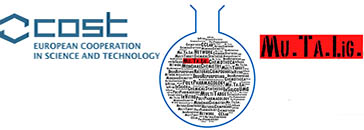
General information
| Name: Slavica |
| Surname: Filipić |
| E-mail: sfilipic@pharmacy.bg.ac.rs |
| Cell phone number with international prefix: + 381 63 83 80 500 |
| Country: Serbia |
| Affiliation: Department of Pharmaceutical Chemistry, University of Belgrade – Faculty of Pharmacy |
| Gender: F T M □ |
| Year of the PhD title: 2013 |
| Personal web page: https://www.researchgate.net/profile/Slavica_Filipic
|
| Previous COST participation: No □ Yes T |
List of 10 selected publications within last 5 years
| 1. L. Ismaili, B. Refouvelet, M. Benchekroun, S. Brogi, M. Brindisi, S. Gemma, G. Campiani, S. Filipic, D. Agbaba, G. Esteban, M. Unzeta, K. Nikolic, S. Butini, J. Marco-Contelles. Multitarget compounds bearing tacrine- and donepezil-like structural and functional motifs for the potential treatment of Alzheimer’s disease, Progress in Neurobiology (2016) http://dx.doi.org/10.1016/j.pneurobio.2015.12.003 |
| 2. S. Filipic, D. Ruzic, J. Vucicevic, K. Nikolic, D. Agbaba. Quantitative structure-retention relationship of selected imidazoline derivatives on α1-acid glycoprotein column. Journal of Pharmaceutical and Biomedical Analysis (2016) http://dx.doi.org/10.1016/j.jpba.2016.02.053 |
| 3. Z. Gagic, K. Nikolic, B. Ivkovic, S. Filipic, D. Agbaba. QSAR studies and design of new analogs of vitamin E with enhanced antiproliferative activity on MCF-7 breast cancer cells. Journal of the Taiwan Institute of Chemical Engineers 59, 33-44 (2016). |
| 4. M. Popovic, G. Popovic, S. Filipic, K. Nikolic, D. Agbaba. The effects of micelles of differently charged surfactants on the equilibrium between (Z)- and (E)-diastereomers of five ACE inhibitors in aqueous media. Monatshefte Fur Chemie 146, 913-921 (2015) |
| 5. O. M. Bautista-Aguilera, A. Samadi, M. Chioua, K. Nikolic, S. Filipic, D. Agbaba, E. Soriano, L. de Andrés, M. I. Rodríguez-Franco, S. Alcaro, R. R. Ramsay, F. Ortuso, M. Yañez, and J. Marco-Contelles. N-Methyl-N-((1-methyl-5-(3-(1-(2-methylbenzyl)piperidin-4-yl)propoxy)-1H-indol-2-yl)methyl)prop-2-yn-1-amine, a New Cholinesterase and Monoamine Oxidase Dual Inhibitor J. Med. Chem., 57, 10455–10463 (2014). |
| 6. K. Nikolic, S. Filipic, D. Agbaba, H. Stark, Procognitive Properties of Drugs with Single and Multitargeting H3 Receptor Antagonist Activities. CNS Neuroscience & Therapeutics 20, 613–623 (2014). |
| 7. B. Filipic, K. Nikolic, S. Filipic, B. Jovcic, D. Agbaba, J. Antic Stankovic, M. Kojic, N. Golic, Identifying the CmbT substrates specificity by using a quantitative structure–activity relationship (QSAR) study. J. Taiwan Inst. Chem. E. 45, 764-771 (2014). |
| 8. S. Filipic, K. Nikolic, I. Vovk, M. Krizman, D. Agbaba, Quantitative structure-mobility relationship analysis of imidazoline receptor ligands in CDs-mediated CE, Electrophoresis, 34, 471–482 (2013). |
| 9. K. Nikolic, S. Filipic, A. Smoliński, R. Kaliszan, D. Agbaba, Partial least square and hierarchical clustering in ADMET modeling: Prediction of blood – brain barrier permeation of α-Adrenergic and imidazoline receptor ligands. Journal of Pharmacy and Pharmaceutical Sciences 16, 622-647 (2013). |
| 10. K. Nikolic, S. Filipic, D. Agbaba, Multi-target QSAR and docking study of steroids binding to corticosteroid-binding globulin and sex hormone-binding globulin. Current Computer-Aided Drug Design 8, 296-308 (2012). |
Main skills and expertise (up to 5)
| 1. Computer-aided drug design |
| 2. Chemometrics |
| 3. Evaluation of physico-chemical properties by use of chromatographic and computational methods |
| 4. Development of analytical methods for analysis of drug substances |
| 5. |
Main equipment/facilities available in the participants’ lab (up to 5)
| 1. Softwares:ChemBioOffice Pro13, Gaussian09W, Simca 12+P, Dragon 6.0, Pentacle 1.0.6, FLAP 2.0.2 , ADMET Predictor, AutoDock Vina 1.1.2, Gold 5.4.0 |
| 2. NMR spectrometer 400 MHz |
| 3. Triple quadrupole mass spectrometer with a heated electrospray ionization |
| 4. |
| 5. |
Short personal activity proposal for the COST Action CA15135 (max 1000 characters)
| · Rational design of novel multi-target ligands as potential drugs for the treatment of complex diseases using molecular modelling, quantitative-structure activity relationships (3D-QSAR), pharmacophore modelling, virtual docking, virtual screening methods (ligand-based-virtual screening, structure-based-virtual screening) and in silico ADMET studies.· Examination of physico-chemical and biopharmaceutical properties of multi-target ligands using in vitro parallel artificial membrane permeability assay (PAMPA), biopartitioning micellar chromatography and protein-based columns. · Application of partial least square regression, principal component analysis, artificial neural networks, and hierarchical clustering for quantitative structure property study of multi-target compounds. · Chemometry and development of analytical methods for examination of multi-target ligands. |
Work Group preference: score from 1 (preferred) to 4 (not preferred)
| Work Group of the CA15135 COST Action | Score |
| WG1: Development of new chemical entities | 1 |
| WG2: Selection of biological targets and assessment of biological data | 4 |
| WG3: Development of chemical databases | 2 |
| WG4: Development of Computational methods for multiple ligand design and discovery | 1 |
